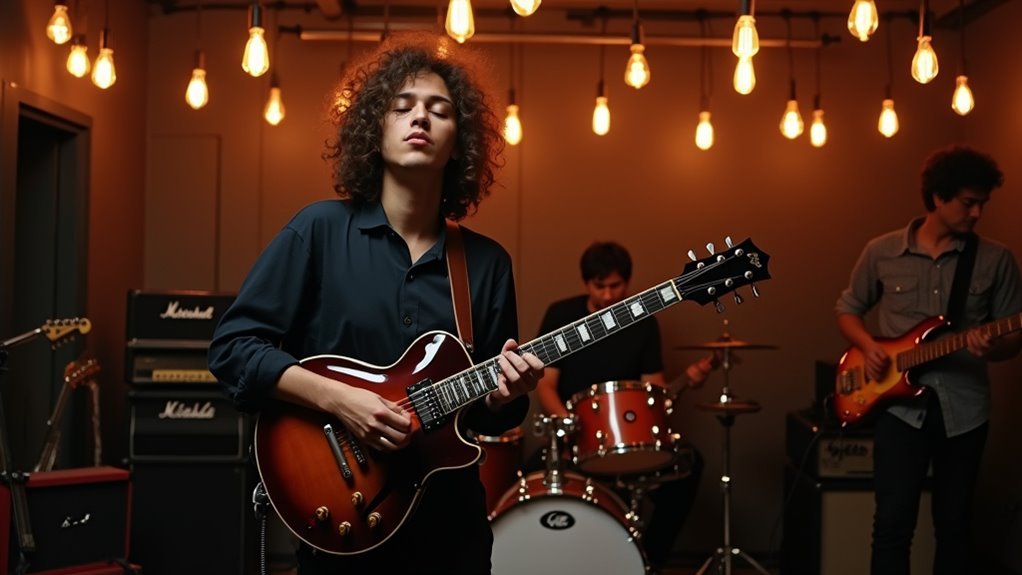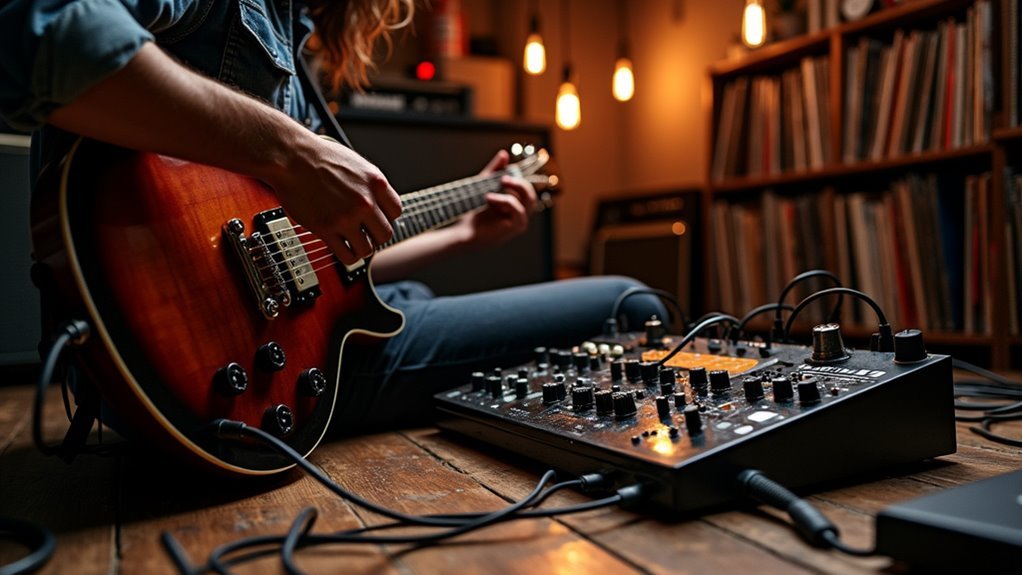Picture yourself as a one-person band, your fingers dancing between crushing power chords and soaring melodic runs. We’re about to reveal the secrets of playing rhythm and lead guitar simultaneously – a skill that’ll transform you from a basic strummer into a versatile powerhouse. It’s not just about fancy fingerwork or theoretical knowledge; it’s about rewiring your musical brain to handle multiple tasks at once. Let’s crack open this technical challenge and master the art of dual-role playing.
Understanding the Fundamentals of Rhythm and Lead Integration

While mastering rhythm and lead guitar separately presents its own challenges, integrating them requires an entirely new level of dedication.
We’ll start by developing your sense of timing – it’s the cornerstone of playing rhythm that even modern metal’s best guitarists prioritize in every practice session.
First, focus on maintaining a steady rhythm while executing basic chord shapes. Once you’ve got that down, we’ll incorporate your ability to improvise lead lines between chord changes.
Think of your lessons on rhythm as building blocks – each one strengthens your foundation for more complex integration. Your fretting hand needs to instinctively know where to go while your picking hand keeps the groove alive.
This dual focus creates the seamless shifts that define advanced guitar work.
Mastering Essential CAGED System Techniques
The CAGED system reveals the entire fretboard’s potential through five fundamental chord shapes.
We’ll leverage these shapes to seamlessly blend rhythm playing and lead guitar through strategic fretboard navigation.
Let’s access the system’s power for maximum musical impact.
- Position 1 of the minor pentatonic scale connects directly with your first minor CAGED chord – essential for fluid shifts.
- Each chord shape pairs with its parallel pentatonic scale, letting you target chord tones during improvisation.
- Barre chords in position 4 create a perfect framework for combining rhythm and lead elements.
- Master chord progressions across CAGED positions to develop versatility in both playing styles.
Building Hand Independence and Coordination

Because rhythm and lead guitar require different mechanical skills, building hand independence forms the foundation of playing both styles simultaneously.
We’ll tackle this through targeted finger independence drills that separate rhythm parts from playing lead lines.
Start with basic coordination exercises: play steady rhythm patterns on lower strings while executing simple lead phrases up top.
Let’s incorporate metronome practice to lock in that steady tempo – it’s non-negotiable. You’ll want a gradual increase in speed as your hands sync up.
Record your practice sessions religiously. Nothing exposes coordination weaknesses like hearing yourself on tape.
Focus on exercises that challenge each hand independently – when your fretting hand can groove while your picking hand solos, you’re golden.
Trust us, your future self will thank you for putting in this foundational work.
Developing Your Hybrid Playing Style
Mastering a hybrid playing style demands three core elements: rhythmic foundation, lead fluency, and seamless changes between them.
Let’s weaponize the CAGED system to connect our rhythm and lead guitar work, enabling targeted improvisation while maintaining tight rhythmic control.
- Play fast without sacrificing clean execution – metronome practice is non-negotiable
- Master palm muting for rhythm sections while developing fluid lead shifts
- Build dynamic contrasts through strategic use of bending and legato techniques
- Cultivate coordination between picking and fretting hands through daily drills
We’re not just learning to switch between rhythm and lead guitar – we’re forging a unified approach.
Your hybrid playing style emerges from relentless practice of these shifts, always maintaining precise timing.
Remember: coordination trumps speed. Start slow, stay measured, and let muscle memory crystallize.
Exploring Effects and Tone Shaping

Effects pedals transform your guitar from a single instrument into an entire sonic arsenal.
Let’s explore crafting a dynamic sound that’ll elevate your playing. Start with distortion for tight, aggressive rhythm guitar tone, then layer delay and reverb to give your lead parts breathing room and atmosphere.
Layer your guitar’s sonic journey with distortion’s aggressive punch, followed by delay and reverb for spacious, atmospheric leads.
We’ll want to experiment with modulation effects too. Chorus adds essential depth, while flanger creates those swirling textures that work for both rhythm and lead lines.
The key is building your unique sound palette by combining these effects strategically.
Record your practice sessions – it’s non-negotiable. You’ll hear exactly how your tone shaping choices affect your overall sound.
Set specific goals for each session, focusing on one effect or technique at a time. This targeted approach speeds up your mastery of effects integration.
Advanced Practice Strategies and Exercises
While many guitarists split their focus between rhythm and lead playing, we’ll revolutionize your practice routine by attacking both simultaneously.
Let’s plunge into advanced strategies that’ll transform your playing.
- Practice alternating between simple rhythm patterns and lead licks daily, using a metronome to maintain a steady tempo.
- Record your practice sessions for critical insights into your technique and areas needing improvement.
- Experiment with different time signatures to develop rhythmic independence between hands.
- Play every exercise slowly at first, then gradually increase speed as your confidence grows.
Armed with these techniques, you’ll master complex rhythms while developing the coordination needed for seamless shifts between rhythm and lead parts.
Real-World Applications and Performance Tips

Successful guitar performances demand more than just technical mastery – they require real-world savvy and stage-ready skills. Let’s explore essential tips for seamlessly blending rhythm and lead parts in live settings.
| Performance Element | Studio Practice | Live Application |
|---|---|---|
| Timing Control | Use a metronome | Custom metronome |
| Sound Analysis | Recording Machine | Listen back |
| Practice Material | Downloadable tabs | Backing track |
We’ve found metal guitar lessons from Riffhard particularly effective for mastering these shifts. Start by recording your practice sessions – it’s brutal but necessary. Layer your effects strategically; delay and reverb can mask timing issues between rhythm and lead sections. Remember: live performance is unforgiving. Your rhythm playing must stay rock-solid while executing lead runs. Keep practicing with a metronome until switching between parts becomes second nature.
Frequently Asked Questions
Should You Learn Rhythm Guitar Before Lead?
We strongly recommend learning rhythm guitar first, as it builds foundational skills in chord progressions and timing. This learning sequence enhances ear training and finger dexterity before tackling lead techniques across musical styles.
How to Balance Lead and Rhythm Guitar?
Like a skilled dancer leading while following, we’ll master syncopation techniques and chord progressions through timing exercises. Balance comes from practiced finger positioning, strumming patterns, groove creation, and dynamic control during musical layering.
Does Keith Richards Play Lead or Rhythm Guitar?
We can see Keith’s style blend both roles – he’s primarily a rhythm guitarist with iconic riffs, but his signature sound includes lead elements, especially during live performances where his guitar techniques seamlessly mix both.
How Can I Improve My Guitar Rhythm and Timing?
Let’s get in the groove! We’ll sharpen our timing through metronome practice, explore strumming patterns and chord progressions, plunge into fingerstyle rhythms, and master syncopation drills for better musical phrasing.